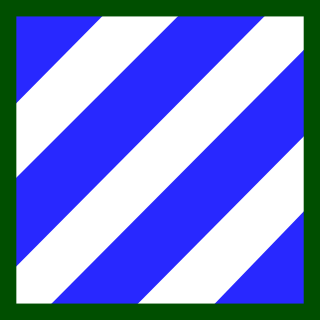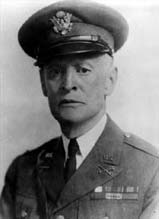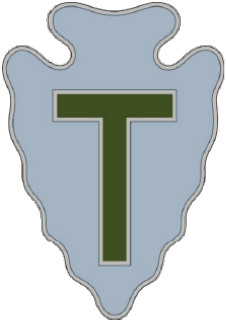Related Research Articles

The 3rd Infantry Division is a combined arms division of the United States Army based at Fort Stewart, Georgia. It is a direct subordinate unit of the XVIII Airborne Corps and U.S. Army Forces Command. Its current organization includes a division headquarters and headquarters battalion, two armored brigade combat teams, one National Guard infantry brigade combat team, one task force battalion, one aviation brigade, a division artillery, a sustainment brigade and a combat sustainment support battalion along with a maneuver enhancement brigade. The division has a distinguished history, having seen active service in World War I, World War II, the Korean War, Vietnam War, and the Global War on Terror. The Medal of Honor has been awarded to 61 members of the 3rd Infantry Division, making the division the most honored in the Army.

The 1st Infantry Division is a combined arms division of the United States Army, and is the oldest continuously serving division in the Regular Army. It has seen continuous service since its organization in 1917 during World War I. It was officially nicknamed "The Big Red One" after its shoulder patch and is also nicknamed "The Fighting First." The division has also received troop monikers of "The Big Dead One" and "The Bloody First" as puns on the respective officially sanctioned nicknames. It is currently based at Fort Riley, Kansas.

The American Expeditionary Forces was a formation of the United States Army on the Western Front of World War I. The AEF was established on July 5, 1917, in France under the command of Gen. John J. Pershing. It fought alongside French Army, British Army, Canadian Army, and Australian Army units against the Imperial German Army. A minority of the AEF troops also fought alongside Italian Army units in that same year against the Austro-Hungarian Army. The AEF helped the French Army on the Western Front during the Aisne Offensive in the summer of 1918, and fought its major actions in the Battle of Saint-Mihiel and the Meuse-Argonne Offensive in the latter part of 1918.

The 4th Infantry Division is a division of the United States Army based at Fort Carson, Colorado. It is composed of a division headquarters battalion, three brigade combat teams, a combat aviation brigade, a division sustainment brigade, and a division artillery.

The 5th Infantry Division (Mechanized)—nicknamed the "Red Diamond", or the "Red Devils" —was an infantry division of the United States Army that served in World War I, World War II and the Vietnam War, and with NATO and the U.S. Army III Corps. It was inactivated on 24 November 1992 and reflagged as the 2nd Armored Division.

First Army is the oldest and longest-established field army of the United States Army. It served as a theater army, having seen service in both World War I and World War II, and supplied the US army with soldiers and equipment during the Korean War and the Vietnam war under some of the most famous and distinguished officers of the U.S. Army. It now serves as a mobilization, readiness and training command.

The 35th Infantry Division, formerly known as the 35th Division, is an infantry formation of the Army National Guard at Fort Leavenworth.

The 42nd Infantry Division (42ID) ("Rainbow") is a division of the United States Army National Guard. The 42nd Infantry Division has served in World War I, World War II and the Global War on Terrorism (GWOT). The division is currently headquartered at the Glenmore Road Armory in Troy, New York.

The 31st Infantry Division ("Dixie") was an infantry division of the United States Army National Guard, active almost continuously from 1917 to 1968. Composed of men from Alabama, Florida, Georgia, Louisiana, Michigan, Illinois, and Mississippi at various points in its existence, the division saw service in both World War I and World War II, and was mobilized during the Korean War, although it was not sent overseas in the latter.

The Pancho Villa Expedition—now known officially in the United States as the Mexican Expedition, but originally referred to as the "Punitive Expedition, U.S. Army"—was a military operation conducted by the United States Army against the paramilitary forces of Mexican revolutionary Francisco "Pancho" Villa from March 14, 1916, to February 7, 1917, during the Mexican Revolution of 1910–1920.

The 1st Armored Brigade Combat Team, 1st Cavalry Division is a cavalry unit of the United States Army based in Fort Hood, Texas.

The 10th Cavalry Regiment is a unit of the United States Army. Formed as a segregated African-American unit, the 10th Cavalry was one of the original "Buffalo Soldier" regiments in the post–Civil War Regular Army. It served in combat during the Indian Wars in the western United States, the Spanish–American War in Cuba and in the Philippine–American War. The regiment was trained as a combat unit but later relegated to non-combat duty and served in that capacity in World War II until its deactivation in 1944.

The 11th Infantry Brigade is an inactive infantry brigade of the United States Army. It was first formed as part of the 6th Division during World War I. It is best known for its service with the 23rd Infantry Division from 1967 through 1971 in the Vietnam War as a light infantry brigade. The brigade is known for its responsibility in the My Lai Massacre.

The 62nd Cavalry Division was an Organized Reserve cavalry unit of the United States Army.

General of the Armies John Joseph Pershing, nicknamed "Black Jack", was a senior United States Army officer. He served most famously as the commander of the American Expeditionary Forces (AEF) on the Western Front during World War I, from 1917 to 1918. In addition to leading the AEF to victory in World War I, Pershing notably served as a mentor to many in the generation of generals who led the United States Army during World War II, including George C. Marshall, Dwight D. Eisenhower, Omar Bradley, Lesley J. McNair, George S. Patton and Douglas MacArthur.

Herbert Jay Brees was a lieutenant general in the United States Army.

The 56th Infantry Brigade Combat Team is a brigade combat team unit of the Texas Army National Guard, part of the 36th Infantry Division.

Major General Edward Mann Lewis, KCMG, was a highly decorated United States Army officer who served his nation for 46 years. During the First World War, he led the 30th Infantry Division when they broke the Hindenburg Line. Upon arrival in France in 1917, he was placed in command of all U.S. forces in Paris. In 1918 he led the 3rd Brigade of the 2nd Infantry Division at Château-Thierry where he was responsible for planning and leading the attack on the strategic town of Vaux. General John J. Pershing then promoted him and placed him in command of the 30th Infantry Division in July 1918. Assigned to the Fourth British Army, the 30th Division broke the Hindenburg Line on September 29, hastening the end of the Great War.

Major General Beaumont Bonaparte Buck was a United States Army officer who served in the Spanish–American War, the Philippine–American War, and World War I. He is best known for his service with the 1st Division during World War I, where he commanded a regiment, brigade and division.

The 124th Cavalry Regiment is a United States Army cavalry regiment, represented in the Texas Army National Guard by 1st Squadron, 124th Cavalry, part of the 56th Infantry Brigade Combat Team at Waco.
References
Citations
- ↑ Historical Section, Army War College 1949, pp. 671–673.
- 1 2 3 Historical Section, Army War College 1949, pp. 673–674.
- 1 2 3 Wilson 1998, p. 64.
- 1 2 3 Historical Section, Army War College 1949, pp. 671–672.
- ↑ Clay 2010, pp. 558, 568–569.
- ↑ Wilson 1999, pp. 123, 125, 127.
Bibliography
- Clay, Steven E. (2010). US Army Order of Battle 1919–1941 (PDF). Vol. 2. Fort Leavenworth, Kansas: Combat Studies Institute Press. ISBN 9781780399171. Archived from the original (PDF) on 1 April 2017. Retrieved 26 August 2018.
- Historical Section, Army War College (1949). Order of Battle of the United States Land Forces in the World War. Vol. 3, Part 2: Zone of the Interior: Territorial Departments, Tactical Divisions Organized in 1918, Posts, Camps, and Stations (Reprint, 1988 ed.). Washington: Government Printing Office. OCLC 976846766.
- Wilson, John B. (1998). Maneuver and Firepower: The Evolution of Divisions and Separate Brigades (PDF). Washington, D.C.: Center for Military History, U.S. Army. ISBN 0-16-049571-7. Archived from the original (PDF) on 1 March 2014. Retrieved 26 August 2018.
- Wilson, John B. (1999). Armies, Corps, Divisions, and Separate Brigades (PDF). Washington, D.C.: Center for Military History, U.S. Army. ISBN 0-16-049994-1. Archived from the original (PDF) on 24 September 2015. Retrieved 26 August 2018.